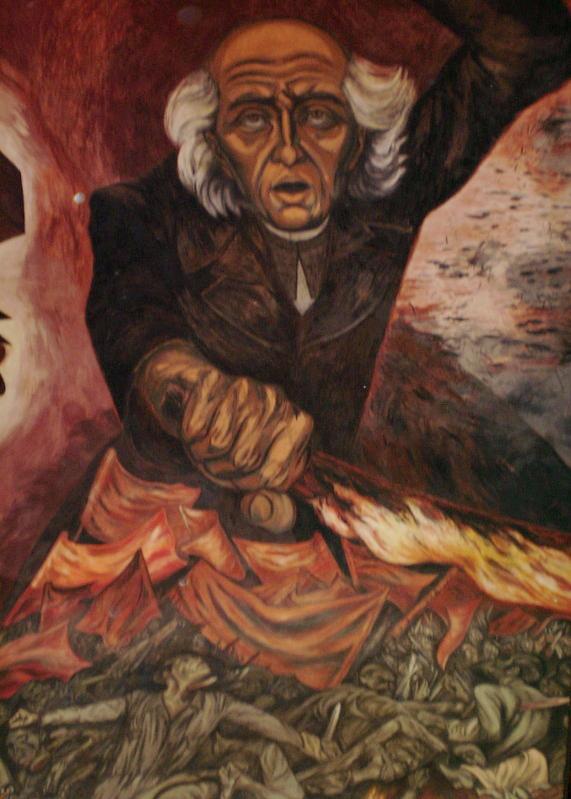
Mexican History: The Independence Struggle (1810-21)

Figure 1.--This powerful portait of Miguel Hidalgo y Costilla by muralist José Clemente Orozco depicts the Grito de Dolores. Hidalgo failed to achieve Mexican independence, but is considered to be the father of the Mexican nation. It is located in Jalisco Governmental Palace, Guadalajara.
|
|
Mexico achieved independence from Spain in part because of the French Revolution and Napoleonic Wars--the Peninsula Campaign. Napoleon replaced the Spanish Bourbons with his brother Joseph (1808). An invading French army supported Joseph. The Spanish resisted the French and the Peninsula Campaign became once of the most destructive and brutal of the Napoleonic era. Spain was devestated and a weakened Spain could not hold on to its colonies. The Mexican elite began to discuss how to govern the colony. New Spain had been ruled from Spain, but this now meant a French monarchy. The Spanish Viceroy attempted to maintain control, but was replaced by European-born Spaniards. Father Miguel de Hidalgo y Costilla, a priest disturbed by the abject poverty of the people, issued his Grito de Dolores--the Cry of Doloraes (1810). He called on the Mexican people to support King Fernando VII (held captive by Napoleon) by revolting against the Spainards who had overthrown the Viceroy. He attracted peasants and other Mexicans who formed the first Mexican Army. It was large, perhaps 90,000 men, but poorly trained and armed. They attacked and killed forces of Spanish Peninsulares and Criollo elites they encountered. This continued until they encountered a force of disciplined Spanish troops. Hidalgo's forces were decisively defeated at the Battle of Calderón Bridge (1811). His army desintegrated, most were either killed or fled. Hidalgo was captured and executed by a firing squad a few months later. The independence movement he inagurated, however, continued the struggle. Vicente Guerrero and the royalist Agustin de Iturbide signed the Treaty of Cordoba creating an independent Mexico (1821). Although it was Itubide who actually achieved independence, it is Hildalgo because of his social message that is seen as the father of the country and September 16, the day Hidalgo issied the Grito de Dolores that is celebrated as Mexican Independence Day.
CIH

Navigate the Cjildren in History WEbsite:
[Return to the Main Mexican history page]
[Return to the Main Mexican page]
[Return to the Main Latin American history page]
[Introduction]
[Animals]
[Biographies]
[Chronology]
[Climatology]
[Clothing]
[Disease and Health]
[Economics]
[Geography]
[History]
[Human Nature]
[Law]
[Nationalism]
[Presidents]
[Religion]
[Royalty]
[Science]
[Social Class]
[Bibliographies]
[Contributions]
[FAQs]
[Glossaries]
[Images]
[Links]
[Registration]
[Tools]
[Children in History Website]
Navigate the HBC Mexican pages
[Mexican choirs]
[Mexican Scouts]
[Mexican school uniforms]
[Mexican communions]
Created: 5:34 AM 11/21/2014
Last updated: 5:34 AM 11/21/2014



